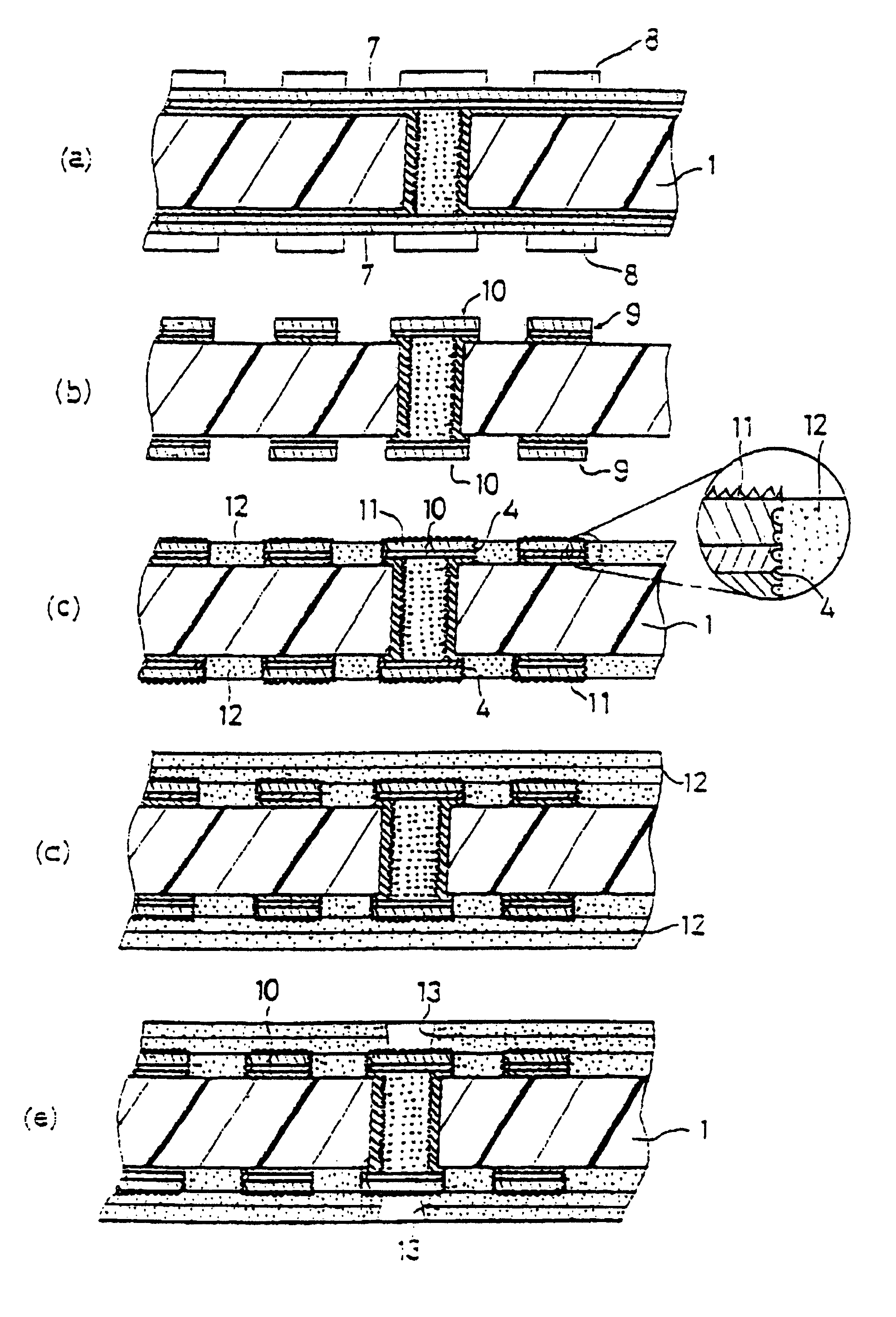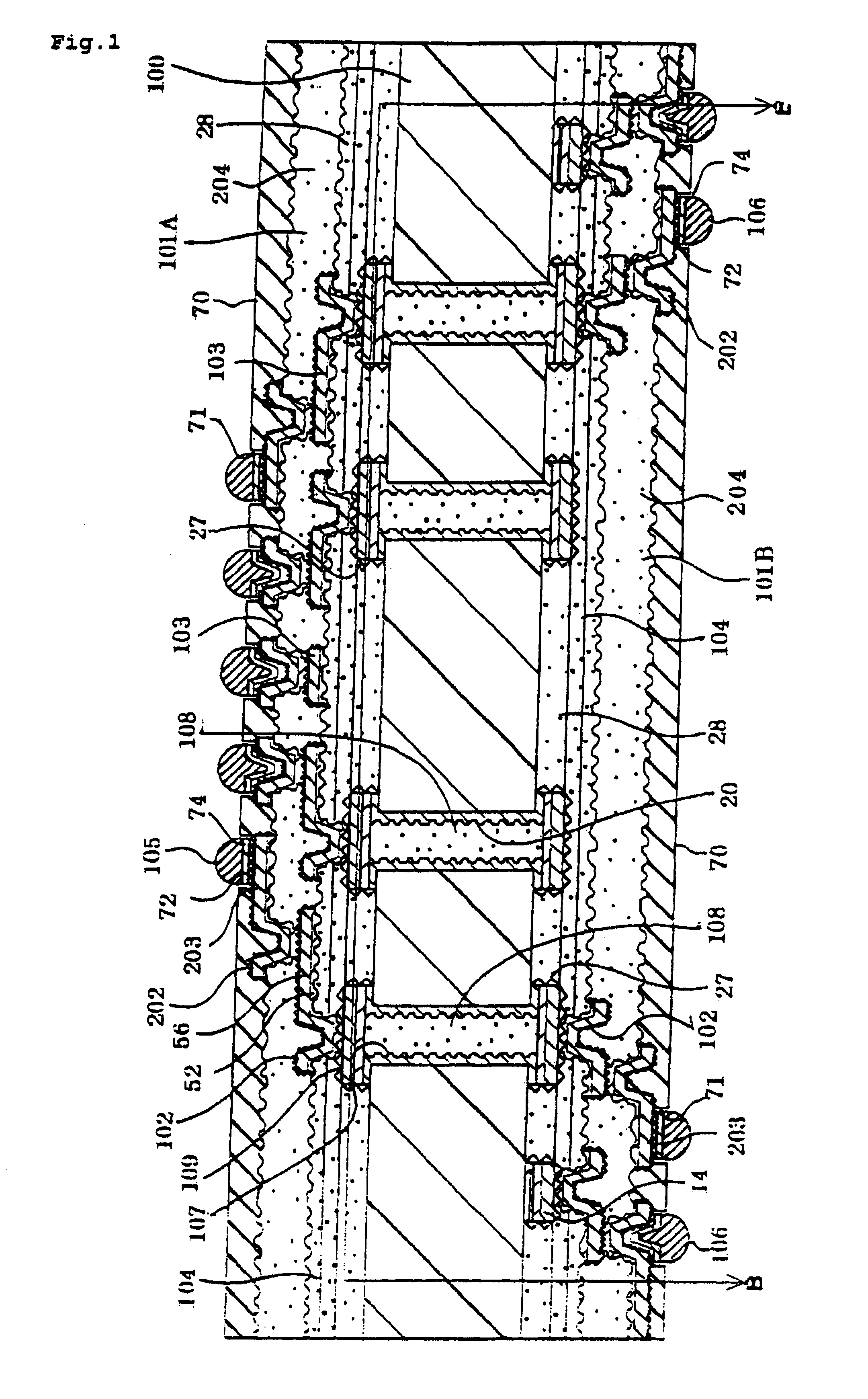Multilayer printed wiring board and its manufacturing method, and resin composition for filling through-hole
- Summary
- Abstract
- Description
- Claims
- Application Information
AI Technical Summary
Benefits of technology
Problems solved by technology
Method used
Image
Examples
example 1
[0153](1) As a starting material, was employed a copper-clad laminate (manufactured by Matsushita Electric Works, Ltd., trade name: R4737) composed of a substrate 1 of a polytetrafluoroethylene resin (hereinafter briefly referred to as trade name: Teflon) of 0.8 mm in thickness and a copper foil 2 of 18 μm in thickness laminated on the substrate 1, the surface adjacent to the copper foil 2 being roughened (see FIG. 2(a)). Initially, the copper-clad laminate was drilled to form a hole and the internal surface of the hole was treated with a modifier (manufactured by Junkosha Co., Ltd., trade name: Tetraetch) composed of an organic metallic sodium to improve the wettability of the surface (see FIG. 2(b)).
[0154]A palladium-tin colloid was then applied to substrate, and the substrate was immersed in an electroless plating solution having the following composition to form an electroless plated film of 2 μm in thickness all over the surface of the substrate.
[0155]
EDTA150g / lCopper sulfate20...
example 2
Multilayer Core Substrate
[0173](1) A two-sided copper-clad laminate 1′ of 0.5 mm in thickness was prepared, and provided with an etching resist on both surfaces, and subjected to an etching treatment with an aqueous solution of sulfuric acid and hydrogen peroxide to obtain a substrate provided with conductor circuits. A glass-epoxy prepreg and a copper foil 2 were in turn laminated onto both surfaces of the substrate, pressed at a temperature raging from 165 to 170° C. and a pressure of 20 kg / cm2 to give a multilayer core substrate 1′ (see FIG. 5(a)).[0174](2) The multilayer core substrate 1′ was then drilled to form through holes having a diameter of 300 μm (see FIG. 5(b)), applied with a palladium-tin colloid and then immersed in an electroless plating solution having the same composition as in Example 1 to form an electroless plated film of 2 μm in thickness all over the substrate. The substrate was then subjected to an electrolytic copper plating in the same condition as in Exam...
example 3
[0198]A multilayer printed wiring board was manufactured in the same manner as in Example 1, except that when through-holes were filled with a copper paste, a through-hole-covering conductor layer 10 for covering an exposed copper paste from the through-holes was not formed. According to this process, pits might be formed because the surface of the copper paste was frequently removed in the formation of openings on an insulating resin layer by a laser beam irradiation.
PUM
| Property | Measurement | Unit |
|---|---|---|
| Length | aaaaa | aaaaa |
| Length | aaaaa | aaaaa |
| Thickness | aaaaa | aaaaa |
Abstract
Description
Claims
Application Information
 Login to View More
Login to View More - R&D
- Intellectual Property
- Life Sciences
- Materials
- Tech Scout
- Unparalleled Data Quality
- Higher Quality Content
- 60% Fewer Hallucinations
Browse by: Latest US Patents, China's latest patents, Technical Efficacy Thesaurus, Application Domain, Technology Topic, Popular Technical Reports.
© 2025 PatSnap. All rights reserved.Legal|Privacy policy|Modern Slavery Act Transparency Statement|Sitemap|About US| Contact US: help@patsnap.com



